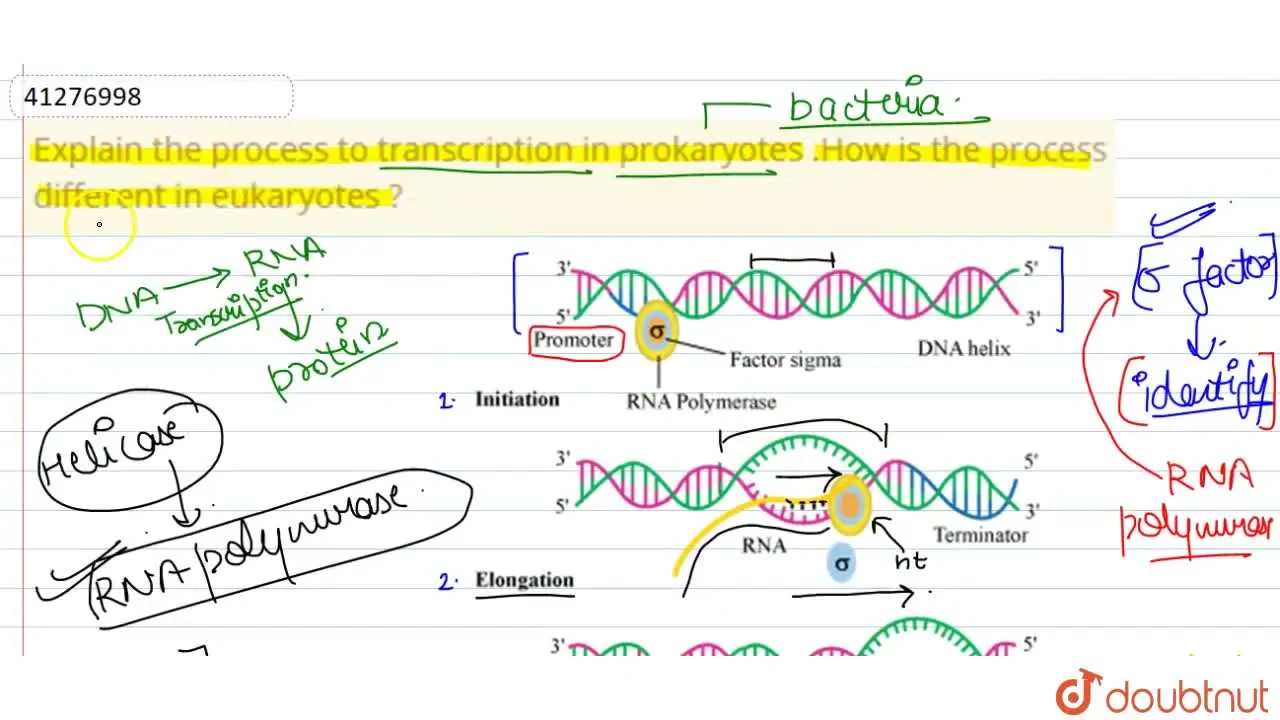Explain the process to transcription in prokaryotes .How is the process different in eukaryotes ?
Video Solution
Text Solution
In prokaryotes (bacteria) there are three major types of RNAS
1. mRNA (messenger RNA)
2. tRNA (transfer RNA)
3. rRNA (ribosomal RNA)
mRNA acts as a template for reading genetic code and rRNA acts as a catalyst, There is a single DNA dependent RN A polymerase for transcription.
The RNA polymerase binds to promoter and initiates transcription. It uses nucleoside triphosphates and polymerization occurs in a template dependent manner. Once the RNA polymeras reaches the terminator region mascent RNA falls off along with RNA polymerare and transcription stops.
Eukaryote gene structure and function differ from prokaryote gene structure and function in several important ways Eukaryotes generally have many more genes and these genes are spread across multiple chromosomes.
Prokaryotes have fewer genes and these genes are all located on one chromosome. Groups of genes producing proteins with related functions are often organized into operons in prokaryotes but not in eukaryotes. Eukaryotes also have DN A that must have its introns excised and the RNA transported out of the nucleus to the ribosomes. The greater complexity of the eukaryote genome means that a greater variety and complexity of control mechanisms is necessary
There are also more steps in the transcription and translation process at which control of expression can occur in eukaryotes. Both the intron and exon are part of the monocistronic eukaryotic DNA. The axons are coding sequences and introns are non coding sequences. The DNA in prokaryotes is polycistronic The primary transcripts in eukaryotes contain both the exons and introns and are hence, it is subjected to a process called splicing where the introns are removed and exons are joined in a defined order.
hnRNA undergo two additional processing called as capping and tailing. In capping an unusual nucleotide (methyl guanosine triphosphate) is added to the 5 -end of hnRNA. In tailing, adenylate residues (200-300) are added at 3 end in a template independent manner.
It is the fully processed hnRNA, now called mRNA, that is transported out of the nucleus for translation . There are least three RNA polymarases in the nucleus of eukaryotes in addition to the RNA polymerase in organelles :
1. RNA polymerase I : trancribes rRNAs (28s,18s,and 5.8s)
RNA polymerase II : Transcribes hnRNA which is the precuresor of mRNA.
RNA polynerase III : transcribes tRNA, 5 sr RNA and sn RNAs.
|
Updated on:21/07/2023
Related Playlists
Similar Questions
Process Of Transcription In Prokaryotes
View SolutionProcess Of Transcription In Eukaryotes
View SolutionDescribe the process of transcription in protein synthesis.
View SolutionExplain the process of regeneration in Planaria. How is this process different from reproduction?
View SolutionExplain the process of regeneration in Planaria. How is this process different from reproduction?
View SolutionDescribe the process of transcription in a bacterium.
View SolutionTranscription is a process by which
View SolutionMitosis is the process by which eukaryotic cells
View Solution(a) Describe the process of transcription in bacteria.
(b) Explain the processing the hnRNA needs to undergo before becoming functional mRNA in eukaryotes.View SolutionHow is a prokaryotic cell different from a eukaryotic cell?
View Solution


